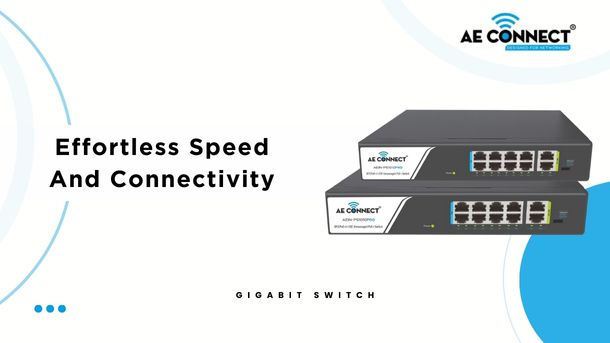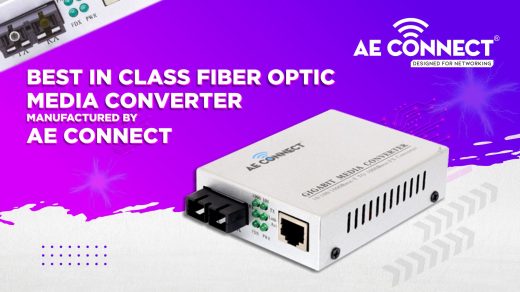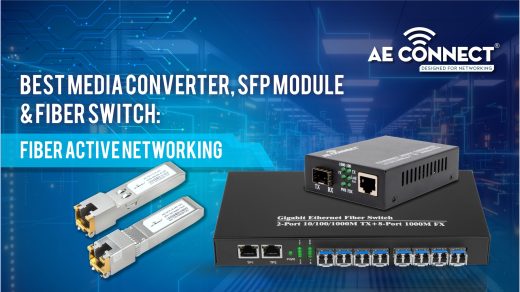A gigabit switch is an essential upgrade for any home or office looking to improve network speeds and connectivity. As more devices and higher bandwidth applications enter networks, legacy 100Mbps switches can create bottlenecks and slow down transfers.
Migrating to a gigabit provides an immediate 10x boost in potential throughput from 100Mbps to 1000Mbps (1Gbps). This blog post will cover the benefits of the switch and help you choose the right model for your needs.
Why a Gigabit Switch?
The switch brings your local area network (LAN) up to modern speed standards. Whereas older 100Mbps switches max out at 12.5MB/s transfers, a gigabit switch can theoretically handle up to 125MB/s.
This enables smooth 4K/8K video streaming, quick file transfers, lag-free online gaming, and more. A gigabit switch future-proofs your network for evolving needs.
With a switch, you can transfer a 100MB file in under 1 second rather than having to wait over 8 seconds on a 100Mbps connection. This time savings applies to every file transfer and can quickly add up to boost productivity. It also reduces latency for applications like video conferencing, VOIP calling, and cloud-synced services.
As more smart home devices like security cameras, video doorbells, and appliances connect to your network, contention for the available bandwidth increases. It provides the necessary headroom to avoid congestion and keep each device operating smoothly.
Choosing the Right Gigabit Switch
When selecting the switch for your needs, a few key factors to consider include:
Port Density
How many devices need to connect? Choose an appropriately sized switch with enough ports. First and foremost, pick a switch that has enough ports for your devices. Desktop models typically range from 5 to 24 ports, while rackmount switches can scale up to 48 ports or more.
Considering both your current and future connectivity needs, having open ports allows room to plug in new devices.
Management Options
Some managed switches allow advanced controls like VLANs and link aggregation. Unmanaged gigabit switches simply forward traffic between ports without any configuration options. Managed switches add features like:
- VLANs – Logically segment your network by device type.
- QoS – Prioritize traffic like VoIP and video.
- Link aggregation – Combine ports for even more bandwidth.
- Monitoring and alerts.
Managed gigabit switch give network admins granular control and visibility but cost more than unmanaged models. Choose this route if you need advanced functionality.
PoE Ports
PoE (Power over Ethernet) enables powering devices like access points and security cameras. PoE ports provide direct power along with data on the Ethernet cable. This allows devices like WiFi access points and security cameras to operate without a nearby AC outlet for power.
If you have PoE devices, select the switch with enough PoE ports to accommodate them. The total power budget of the switch will also need to meet the requirements of all connected PoE devices.
Rackmount vs Desktop
Rackmount fits in a standard 19″ rack while desktop models sit on a shelf. Rackmount switches come in a standard 19” width to install into server racks along with other IT equipment.
Desktop models have a smaller standalone form factor to sit on a shelf. Rackmount is preferred for larger-scale deployments in server closets and data centers. For office and home office settings, a desktop gigabit switch typically works fine.
Layer 2 vs Layer 3
Layer 3 switches can route between VLANs. Layer 2 switches simply pass traffic directly between ports on the same VLAN. But Layer 3 switches can route between different VLANs using advanced IP forwarding capabilities. This inter-VLAN routing happens locally on the switch instead of having to send traffic to an external router. Keep this distinction in mind – some models marketed as gigabit switches are Layer 3 switches with routing functions.
Benefits of a Gigabit Switch
Upgrading to a gigabit switch provides several key benefits:
- Faster File Transfers: The most noticeable benefit is significantly faster file transfers. Gigabit speeds can transfer large files in seconds instead of minutes.
- Smoother Video Streaming: High-bandwidth 4K and 8K video streams will play smoothly without buffering on a gigabit connection. Video calls and conferencing also see improved quality.
- Reduced Network Congestion: With more bandwidth headroom, there is less competition between devices and applications on your network. Everything runs faster.
- Future Proofing: Gigabit switching prepares your network for evolving technology needs down the road. You’ll be ready as 100Mbps speeds become outdated.
Key Applications of a Gigabit Switch
Some main use cases take advantage of gigabit speeds:
Media Streaming
Whether streaming movies, TV shows, or your own media library over the network, a gigabit switch enables smooth playback.
Gaming
Fast-action video games require low latency. The switch provides minimal lag for a competitive edge.
Network Storage
Accessing and transferring files to and from NAS devices is far quicker with a gigabit backbone.
Smart Home
Gigabit switching prevents congestion and bottlenecking as more smart home devices come online.
The Future of Gigabit Switching
Gigabit speeds are just getting started:
- 10 Gigabit and Beyond: 10GbE, 40GbE, and even 100GbE switches will become mainstream as bandwidth demands continue rising.
- PoE Improvements: Higher wattage PoE switches will accommodate more power-hungry endpoint devices.
- Cloud Integration: Switches will become more integrated with the cloud for centralized, remote management.
- Smarter Traffic Handling: Continued improvements to QoS, buffering, and routing will optimize network traffic flow.
Gigabit switching is an important step into the future. While gigabit is fast by today’s standards, even faster switches are coming down the line.
Time to Upgrade to Gigabit Switch with AE Connect
The speed and connectivity potential unlocked by a gigabit switch make it one of the best network upgrades you can pursue. Ditch that old 100Mbps switch and step up to gigabit performance. Your network traffic will flow smoothly as you add more devices and bandwidth-hungry applications in the future.
Contact AE Connect to explore your gigabit switch options tailored to your environment. The company delivers high-quality, efficient, and reliable networking products. With 1000+ successful works and 1500+ happy customers, the company strives to provide 100% customer satisfaction.
Conclusion:
In conclusion, upgrading your network with a gigabit switch is a crucial step in improving speeds and connectivity for both home and office environments. With the increasing number of devices and bandwidth-intensive applications, legacy switches can create bottlenecks and slow down transfers. Migrating to a gigabit switch provides an immediate 10x boost in potential throughput, additionally, a gigabit switch future-proofs your network for evolving needs, ensuring that you stay ahead of the curve as technology advances. Consider the key factors discussed in this blog when choosing the right gigabit switch for your needs, and contact AE Connect to explore your options for a high-quality, efficient, and reliable networking upgrade.




